A Simplified Framework for the Equity-Based Spatial Assessment of Alternative Public Transport Networks
Abstract
1. Introduction
2. Materials and Methods
2.1. Towards an Index to Evaluate Transport Equity
2.2. Building a Simplified Equity-Based Framework for a Public Transport-Network Assessment
- The equity of the stop locations; the spatial distribution of stops must ensure a good balance of travel speeds and short access distances, which depend on the urban structure and the related pattern of lines [11]. In any case, if equity is to be considered in the process of locating the stops, it is necessary to guarantee the coverage of the areas with the highest TNI and, obviously, of the areas in which the main activities are located, i.e., where the points of interest (POI) generate attraction. Guaranteeing access to a transit network for the whole population is indeed the first step towards horizontal equity; ensuring that the most vulnerable categories are covered is another step towards vertical equity. An indicator of the equity of the areas where the stops can be located is here introduced, namely the Equity of Stops (ES) index, which is calculated using the weighted combination of these two factors, normalized in order to be compared, as shown in the following equation:
- The equity of the line routes; the choice of the route of the lines must follow the main trip patterns according to the needs of the various users, guaranteeing coverage of the greatest number of possible destinations with a feasible number of stops. This is to minimize the number of transfers that the user must undertake to reach the final destination. In this case, the directness of the line between the origins and desired destinations ensures greater equity among all users. Of course, in the case of complex networks, this would not result in a single possible combination of lines but in different alternative sets. In this case, the difference in RA index (ΔRA) of two alternative projects I and J could be considered to evaluate the equity of the alternative networks, as follows:
3. Application to the Case Study
3.1. Territorial Framework and Public Transport Supply
3.2. Data and Application
- -
- Zonation and network modeling, including both private and public transport;
- -
- The calculation of the ES index and comparing it with the position of the current stops;
- -
- The calculation of for two alternative networks.
3.2.1. Zonation and Network Modeling
3.2.2. Calculation of the TNI, POI and ES Indexes
3.2.3. Calculation of the for Two Alternative Networks and the Final
4. Results
5. Conclusions
Author Contributions
Funding
Institutional Review Board Statement
Informed Consent Statement
Data Availability Statement
Acknowledgments
Conflicts of Interest
References
- Currie, G. Quantifying spatial gaps in public transport supply based on social needs. J. Transp. Geogr. 2010, 18, 31–41. [Google Scholar] [CrossRef]
- Delbosc, A.; Currie, G. Using Lorenz curves to assess public transport equity. J. Transp. Geogr. 2011, 19, 1252–1259. [Google Scholar] [CrossRef]
- Ricciardi, A.M.; Xia, J.; Currie, G. Exploring public transport equity between separate disadvantaged cohorts: A case study in Perth, Australia. J. Transp. Geogr. 2015, 43, 111–122. [Google Scholar] [CrossRef]
- Ruiz, M.; Pons, J.M.S.; Lladó, J.M.; Reynés, M.R.M. Improving equity of public transportation planning. The case of Palma de Mallorca (Spain). In Proceedings of the AGILE’2014 International Conference on Geographic Information Science, Castellón, Spain, 3–6 June 2014. [Google Scholar]
- Rofé, Y.; Martens, K.; Eran, B.E.; Mednik, N. Accessibility and Social Equity in Tel-Aviv Metropolitan Area—Examination of the current conditions and development scenarios. Tech. Rep. 2015. [Google Scholar] [CrossRef]
- Giuffrida, N.; Inturri, G.; Caprì, S.; Spica, S.; Ignaccolo, M. The impact of a bus rapid transit line on spatial accessibility and transport equity: The case of Catania. In Transport Infrastructure and Systems; CRC Press: Boca Raton, FL, USA, 2017; pp. 753–758. [Google Scholar] [CrossRef]
- Giuffrida, N.; Ignaccolo, M.; Inturri, G.; Rofè, Y.; Calabrò, G. Investigating the Correlation between Transportation Social Need and Accessibility: The Case of Catania. Transp. Res. Procedia 2017, 27, 816–823. [Google Scholar] [CrossRef]
- Karner, A. Assessing public transit service equity using route-level accessibility measures and public data. J. Transp. Geogr. 2018, 67, 24–32. [Google Scholar] [CrossRef]
- Fan, W.; Machemehl, R.B. Bi-Level optimization model for public transportation network redesign problem: Accounting for equity issues. Transp. Res. Rec. 2011, 2263, 151–162. [Google Scholar] [CrossRef]
- Camporeale, R.; Caggiani, L.; Ottomanelli, M. Modeling horizontal and vertical equity in the public transport design problem: A case study. Transp. Res. Part A Policy Pract. 2019, 125, 184–206. [Google Scholar] [CrossRef]
- Camporeale, R.; Caggiani, L.; Fonzone, A.; Ottomanelli, M. Quantifying the impacts of horizontal and vertical equity in transit route planning. Transp. Plan. Technol. 2016, 40, 28–44. [Google Scholar] [CrossRef]
- Caggiani, L.; Camporeale, R.; Ottomanelli, M. Facing equity in transportation Network Design Problem: A flexible constraints based model. Transp. Policy 2017, 55, 9–17. [Google Scholar] [CrossRef]
- Kim, M.; Kho, S.-Y.; Kim, D.-K. A Transit Route Network Design Problem Considering Equity. Sustainability 2019, 11, 3527. [Google Scholar] [CrossRef]
- Park, S.J.; Kang, S.; Byon, Y.-J.; Kho, S.-Y. Multiobjective Approach to the Transit Network Design Problem with Variable Demand considering Transit Equity. J. Adv. Transp. 2022, 2022, 5887985. [Google Scholar] [CrossRef]
- Lucas, K.; Grosvenor, T.; Simpson, R. Transport, the Environment and Social Exclusion; Joseph Rowntree Foundation/York Publishing Ltd.: York, UK, 2001. [Google Scholar]
- Lucas, K. Running on Emptytransport, Social Exclusion and Environmental Justice; Policy Press: Bristol, UK, 2004. [Google Scholar] [CrossRef]
- Martens, K. Justice in Transport: Applying Walzer’s ‘Spheres of Justice’ to the transport sector. In Proceedings of the 88th Annual Meeting of the Transportation Research Board, Washington DC, USA, 11–15 January 2009. [Google Scholar]
- Lucas, K. Transport and social exclusion: Where are we now? Transp. Policy 2012, 20, 105–113. [Google Scholar] [CrossRef]
- Hine, J.; Mitchell, F. Better for everyone? Travel experiences and transport exclusion. Urban Stud. 2001, 38, 319–332. [Google Scholar] [CrossRef]
- Macpherson, S. Julian Hine and Fiona Mitchell. Transport Disadvantage and Social Exclusion: Exclusionary Mechanisms in Transport in Urban Scotland. Soc. Policy 2004, 33, 525–526. [Google Scholar] [CrossRef]
- Hine, J.; Grieco, M. Scatters and clusters in time and space: Implications for delivering integrated and inclusive transport. Transp. Policy 2003, 10, 299–306. [Google Scholar] [CrossRef]
- Currie, G. Gap Analysis of Public Transport Needs:Measuring Spatial Distribution of Public Transport Needs and Identifying Gaps in the Quality of Public Transport Provision. Transp. Res. Rec. J. Transp. Res. Board 2004, 1895, 137–146. [Google Scholar] [CrossRef]
- Currie, G.; Stanley, J.; Stanley, J. No Way To Go: Transport and Social Disadvantage in Australian Communities; Monash University ePress: Melbourne, Australia, 2007. [Google Scholar]
- Currie, G.; Richardson, T.; Smyth, P.; Vella-Brodrick, D.; Hine, J.; Lucas, K.; Stanley, J.; Morris, J.; Kinnear, R.; Stanley, J. Investigating links between transport disadvantage, social exclusion and well-being in Melbourne–Preliminary results. Transp. Policy 2009, 16, 97–105. [Google Scholar] [CrossRef]
- Mestre, F.X.S. Accessibility and Equity Assessment in Public Transport Services: A Case Study in Palma de Mallorca. Ph.D. Dissertation, KTH Royal Institute of Technology, Stockholm, Sweden, 2021. [Google Scholar]
- ISTAT. Esclusione Sociale. 2015. Available online: https://www.istat.it/it/archivio/esclusione+sociale (accessed on 1 December 2022).
- Preston, J.; Rajé, F. Accessibility, mobility and transport-related social exclusion. J. Transp. Geogr. 2007, 15, 151–160. [Google Scholar] [CrossRef]
- Ignaccolo, M.; Inturri, G.; Giuffrida, N.; Torrisi, V. Public Transport Accessibility and Social Exclusion: Making the Connections. In Proceedings of the International Conference on Traffic and Transport Engineering (ICTTE), Belgrade, Serbia; 2016. [Google Scholar]
- Guo, Y.; Chen, Z.; Stuart, A.; Li, X.; Zhang, Y. A systematic overview of transportation equity in terms of accessibility, traffic emissions, and safety outcomes: From conventional to emerging technologies. Transp. Res. Interdiscip. Perspect. 2020, 4, 100091. [Google Scholar] [CrossRef]
- Aman, J.J.C.; Smith-Colin, J. Transit Deserts: Equity analysis of public transit accessibility. J. Transp. Geogr. 2020, 89, 102869. [Google Scholar] [CrossRef]
- Ciommo, F.D. How the Inaccessibility Index Can Improve Transport Planning and Investment. Discussion Paper, International Transport Forum, Paris, France. 2018. Available online: https://www.itf-oecd.org/sites/default/files/docs/inaccessibility-index-transport-planning-investment_0.pdf (accessed on 1 December 2022).
- Hansen, W.G. How accessibility shapes land use. J. Am. Inst. Plan. 1959, 25, 73–76. [Google Scholar] [CrossRef]
- Ceder, A. Public Transit Planning and Operation: Theory Modeling and Practice; Butterworth-Heinemann: Oxford, UK; Elsevier: Oxford, UK, 2007. [Google Scholar]
- Desaulniers, G.; Hickman, M. Public Transit. In Handbooks in Operations Research and Management Science; Barnhart, C., Laporte, G., Eds.; Transportation: Amsterdam, The Netherlands, 2007; Volume 14, pp. 69–128. [Google Scholar]
- ISTAT. Basi Territoriali E Variabili Censuarie. 2011. Available online: https://www.istat.it/it/archivio/104317 (accessed on 1 December 2022).
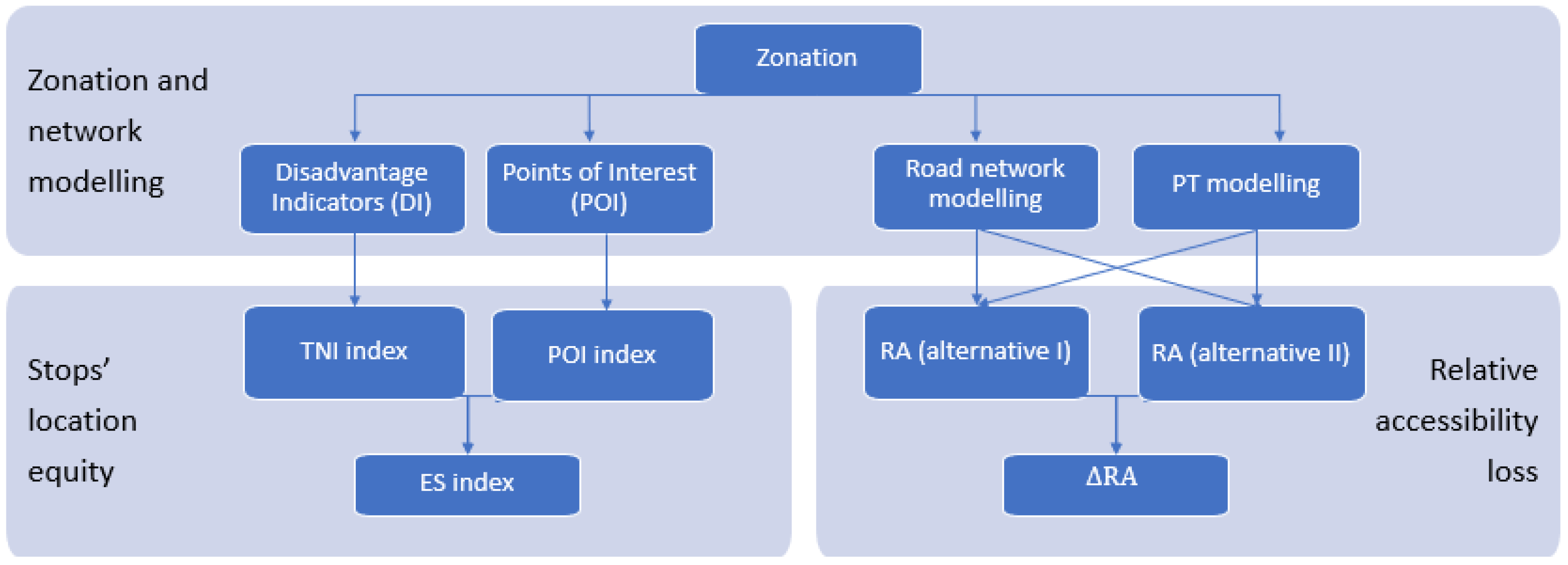
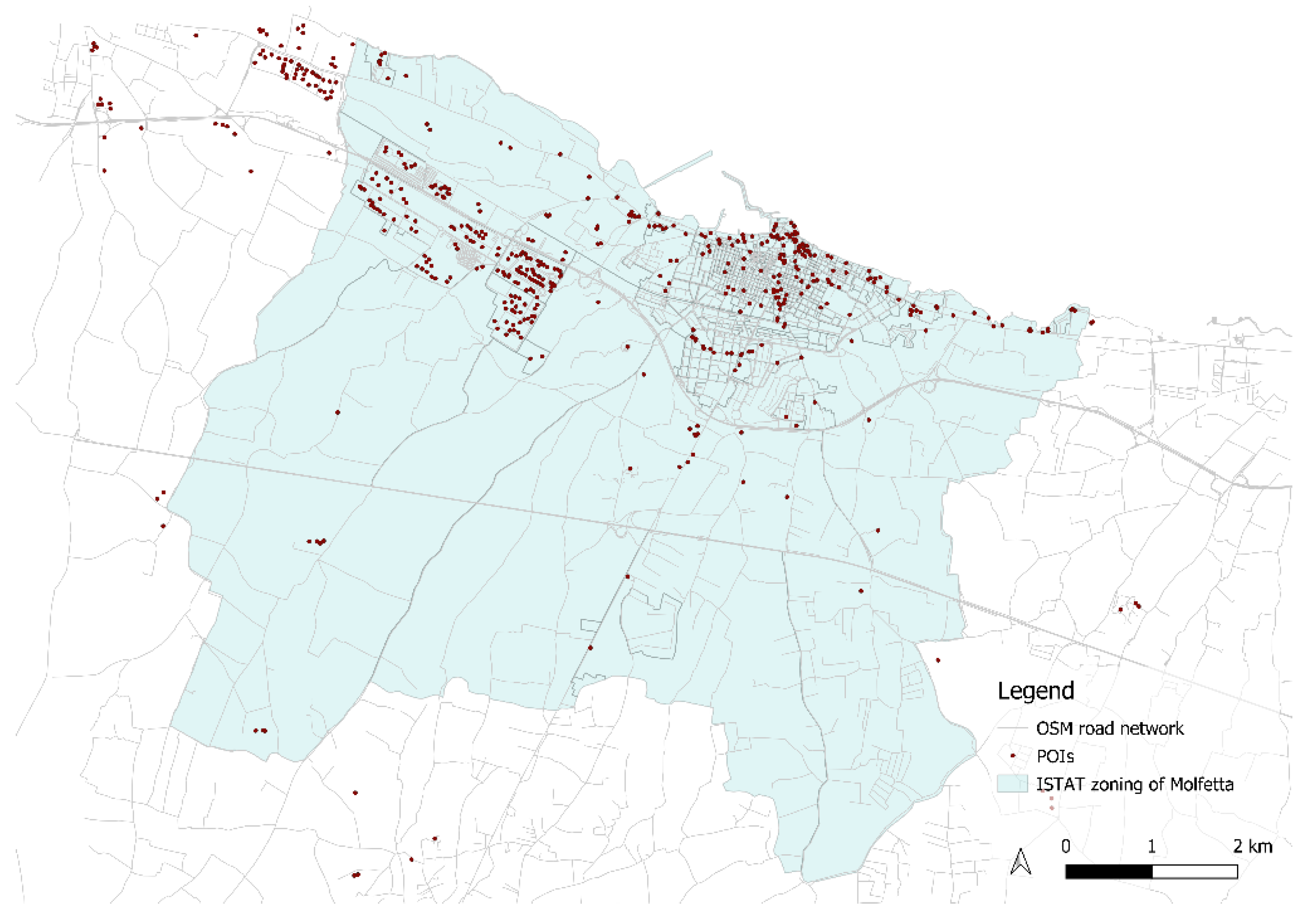
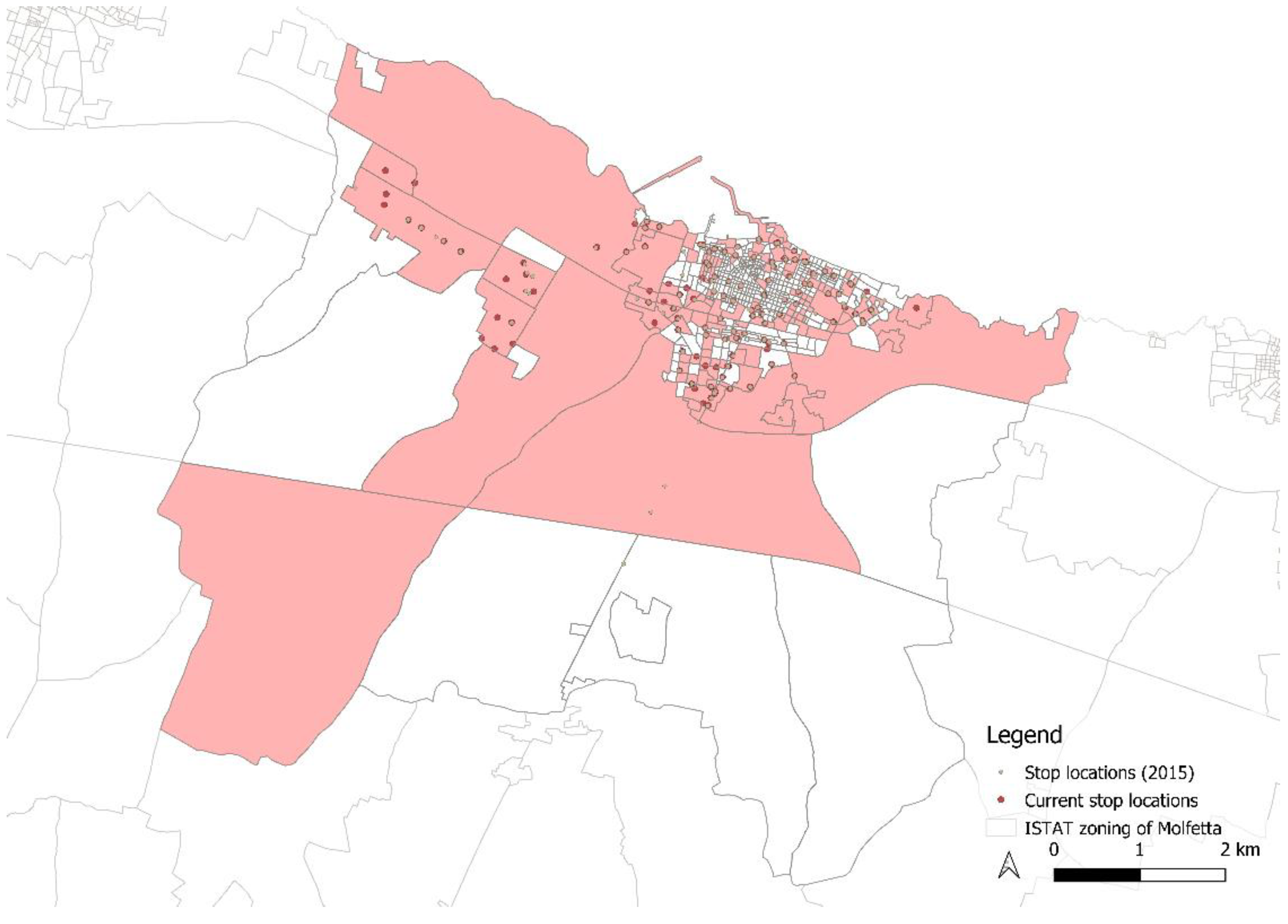
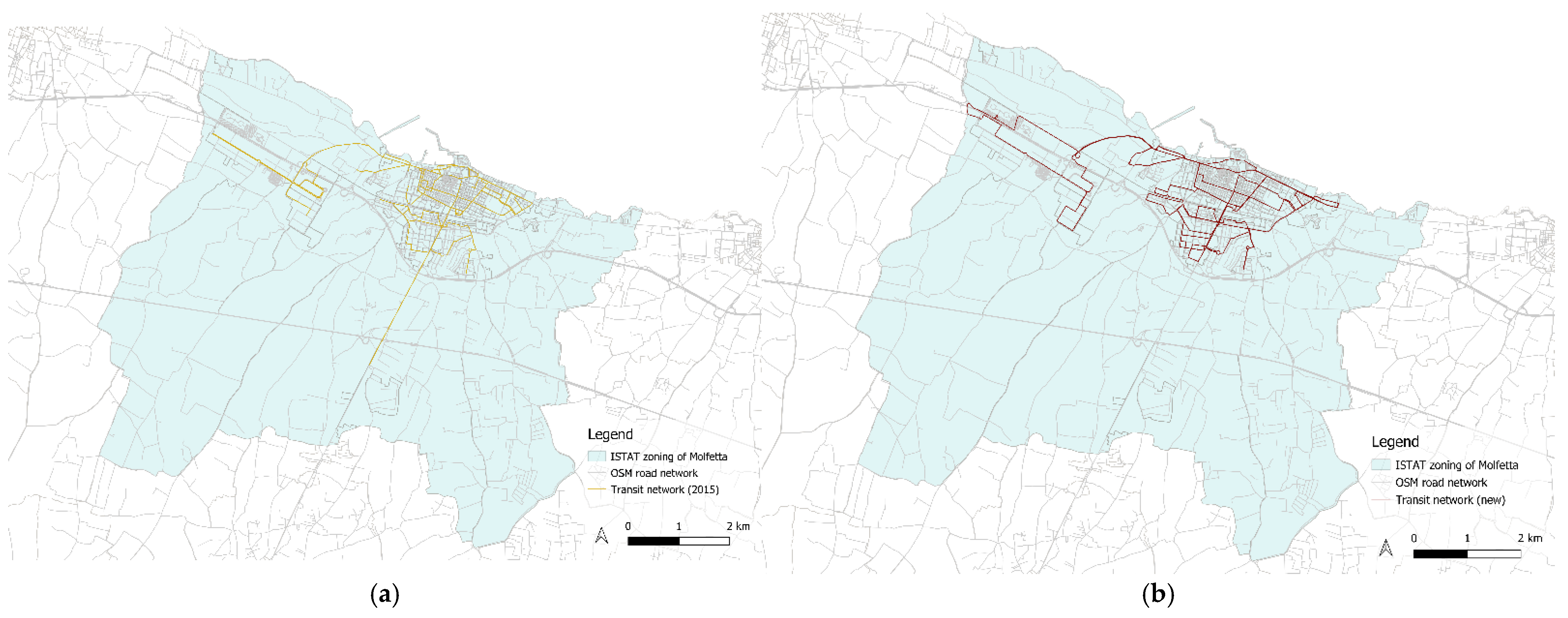
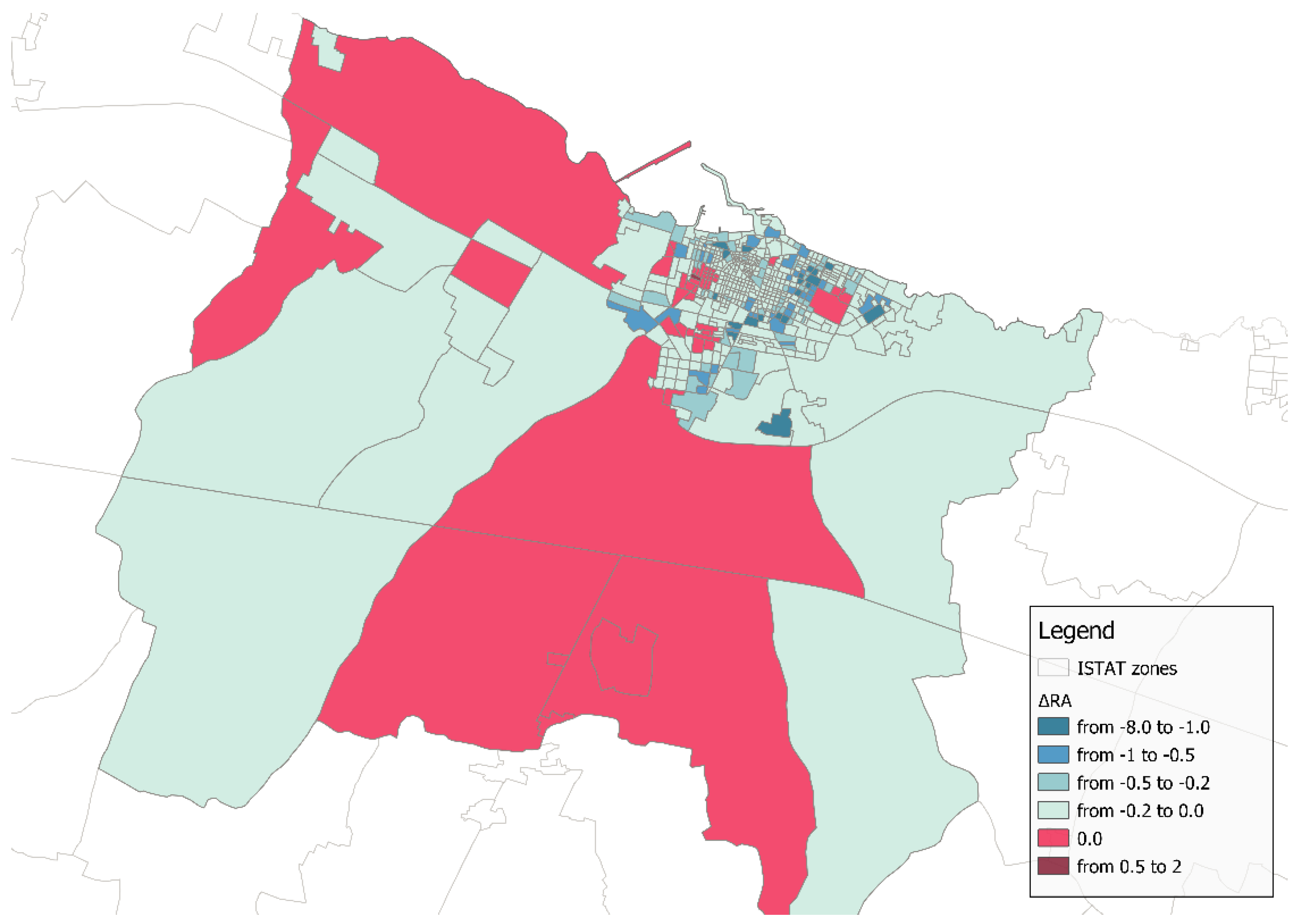
| Indicator | Source |
|---|---|
| Forced car ownership/zero car ownership | [1] |
| Age (elderly people) | [1,19] |
| People with disabilities | [1,19] |
| Low-income households | [1,19] |
| People over 15 without a job | [1] |
| Students | [1] |
| Age (youngsters) | [1,21,25] |
| Young people abandoning education and training | [26] |
| Population living in rural areas | [26] |
| Overcrowding | [26] |
| Gender (women) | [21,25] |
| Nationality (foreigners) | [25] |
Publisher’s Note: MDPI stays neutral with regard to jurisdictional claims in published maps and institutional affiliations. |
© 2022 by the authors. Licensee MDPI, Basel, Switzerland. This article is an open access article distributed under the terms and conditions of the Creative Commons Attribution (CC BY) license (https://creativecommons.org/licenses/by/4.0/).
Share and Cite
Giuffrida, N.; Binetti, M.; Viscio, S.; Ottomanelli, M. A Simplified Framework for the Equity-Based Spatial Assessment of Alternative Public Transport Networks. Sustainability 2022, 14, 16606. https://doi.org/10.3390/su142416606
Giuffrida N, Binetti M, Viscio S, Ottomanelli M. A Simplified Framework for the Equity-Based Spatial Assessment of Alternative Public Transport Networks. Sustainability. 2022; 14(24):16606. https://doi.org/10.3390/su142416606
Chicago/Turabian StyleGiuffrida, Nadia, Mario Binetti, Salvatore Viscio, and Michele Ottomanelli. 2022. "A Simplified Framework for the Equity-Based Spatial Assessment of Alternative Public Transport Networks" Sustainability 14, no. 24: 16606. https://doi.org/10.3390/su142416606
APA StyleGiuffrida, N., Binetti, M., Viscio, S., & Ottomanelli, M. (2022). A Simplified Framework for the Equity-Based Spatial Assessment of Alternative Public Transport Networks. Sustainability, 14(24), 16606. https://doi.org/10.3390/su142416606









